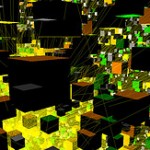In the near future, we will assume that everything has a tiny chip in it, making it intelligent. Physics of the Future
Last year, Tennessee State University became a pioneer in providing campus safety – by requiring faculty, staff, students, and visitors to wear visible ID at all times:
“Students will receive a special lanyard that prominently displays their ID badge. . . Anyone found on campus that is not wearing the ID can be compelled to leave.”
Though not GPS enabled, chipped badges can log a permanent record of every TSU building wearers visit. Such a system may be a viable option to consider within courthouses, in which authorities are considering ways to prevent crime:
“It’s our responsibility at the sheriff’s office to see that it’s secure for the protection of all the judges, the employees that work there, the citizens in the courthouse or attending courts, as well as the lawyers and the prisoners.”
The idea of going whole hog digital is gathering steam, as the world of plastic in your wallet gives way to apps in your pocket – with digital driver’s licenses currently under consideration in California, Delaware, Arizona, and New Jersey. The virtual driver’s license is part of a larger, long term trend toward tangible wallet replacement.
The convergence of technology (for both safety and convenience) is congruent with the moral imperatives of life valuation and goodness. No one would argue there is anything wrong with keeping individuals safe, or with increasing ease of data management (e.g., driver license apps can be modified online, then SMART phone synced).
In the race toward the new and shiny Johnson (2013) however urges caution; “. . . prospective technologies have the potential to transgress the principles of goodness (as well as the life valuation principle). Societal concern is further heightened . . . when such prospective technologies sometimes involve tinkering with the natural order of things, thereby venturing into an unknown territory.”
A potential slippery slope is the adoption of technology, whereby workers are shielded from its full usage – when they don’t know what data sensors are collecting about them in the first place. Kurzweil explains that future persons will derive pleasure from virtual immersion: “we will be able to have any type of desired experience with anyone, real or simulated, in virtual reality.” Imagine the scenario for a company that’s using technology (unbeknownst to its employees) for the enjoyment of management:
_________________________________________________________________________
The following futuristic scenario describes the fantasizing of Edwin (C*TEGYM senior vice president) regarding one of his “favorite” workers, Blanche G.).
“With the chip, I can make all roads leading to Big Daddy look like an accident. One push of a button tells me where she is and who she’s with. Sometimes, when I can see she’s in a part of the company by herself, I’ll just show up – I keep telling her great minds think alike, or some such cliche. The great thing is that ChpCh*m threw in a special first responder bonus just for me; something they wanted me to keep to myself.
One of their programmers did some fancy programming footwork and formulated a private hologram – so now, not only do I get to hear Blanche’s conversations in real time, but I get to see her right in front of me, as if she’s actually speaking. Wherever I am, there she is, just as if I could reach out and touch her. This makes my fantasizing feel real, like I can touch it, taste it, see it, hold it in my arms. Enter inside of it again and again and again.
In my opinion, this high technology is just wonderful.”
_________________________________________________________________________
Reference and Related posts:
Johnson, C. S. (2013). Ambiguous Technologies: Philosophical Issues, Practical Solutions. Human Nature Proceedings of the 2013 Computer Ethics Philosophical Enquiry (CEPE) Conference. In E. A. Buchanan, P. B. deLatt, H. T. Tavani, & J. Klucarich (Eds.).
The merging of man and machine (part I)
The wonders of an embedded chip world (part II)
RFID up close and personal (part III)
Ways to recognize stalking at work





Recent Comments